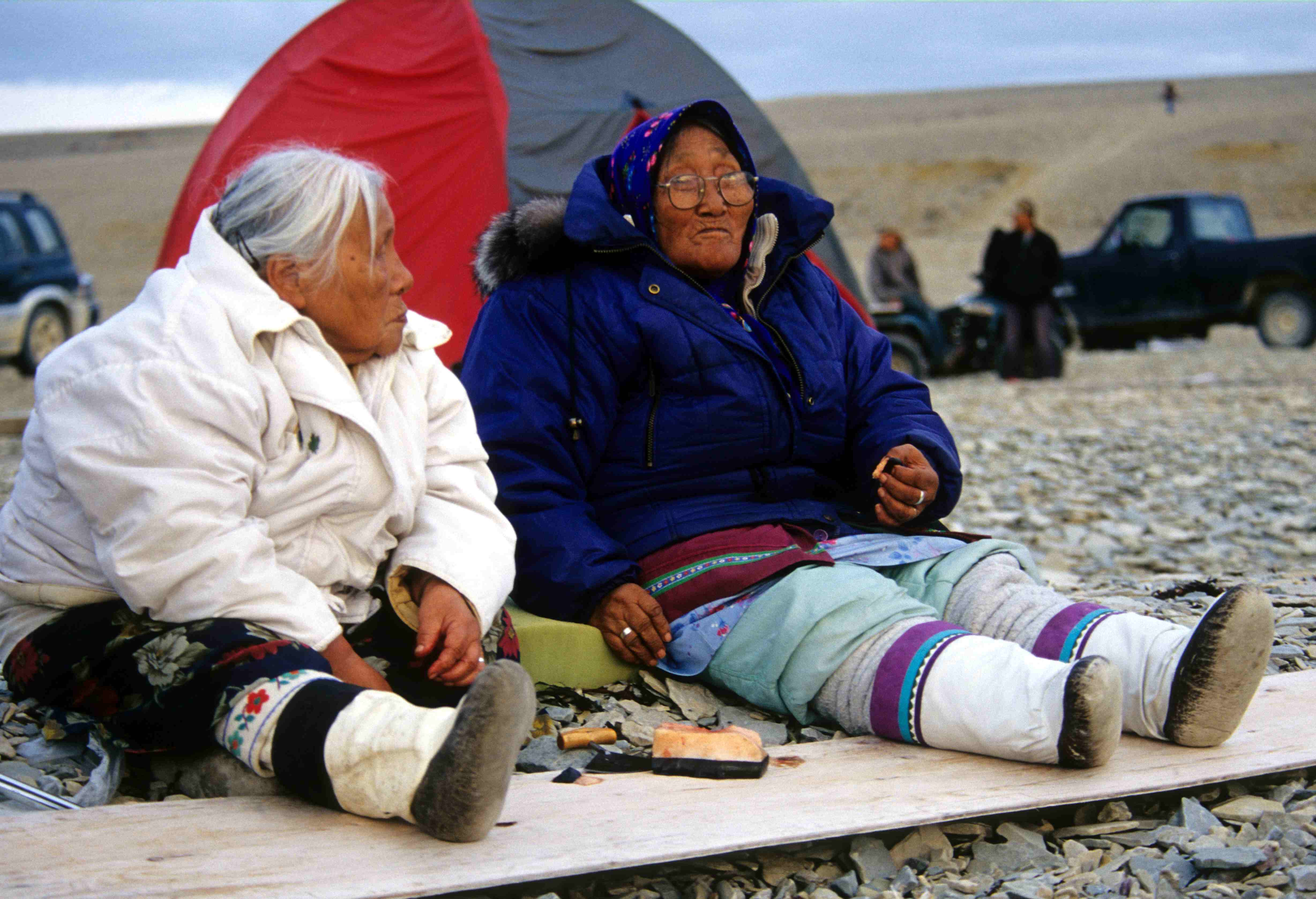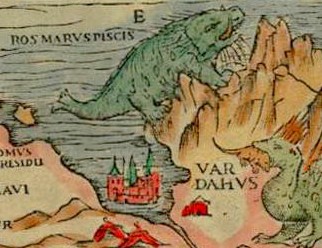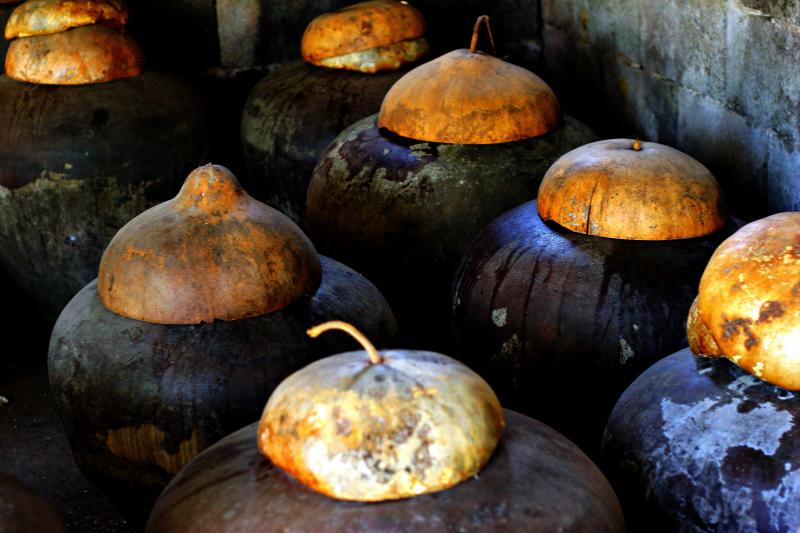|
Igunaq
Igunaq ( iu, ᐃᒍᓇᖅ) ), also Kopalhen ( ckt, копалгын, kopalgyn, IPA opaɬɣən - part of the Inuit, Chukchi, Nenets, Evenki diets. It is a method of preparing meat, particularly walrus and other marine mammals. Meat and fat caught in the summer is buried in the ground as steaks, which then ferment over autumn and freeze over winter, ready for consumption the next year. Igunaq is considered a delicacy and is quite valuable. Consumption has declined over the years as a wider range of foodstuffs has become available in the Arctic regions. It is also not without risk – improper production can lead to illness and death through botulism. Fermented fish and fermented food In food processing, fermentation is the conversion of carbohydrates to alcohol or organic acids using microorganisms—yeasts or bacteria—under anaerobic (oxygen-free) conditions. Fermentation usually implies that the action of microorgani ... is part of many traditional cuisines worldwide. ... [...More Info...] [...Related Items...] OR: [Wikipedia] [Google] [Baidu] |
Walrus Meat 1 1999-04-01
The walrus (''Odobenus rosmarus'') is a large flippered marine mammal with a discontinuous distribution about the North Pole in the Arctic Ocean and subarctic seas of the Northern Hemisphere. The walrus is the only living species in the family Odobenidae and genus ''Odobenus''. This species is subdivided into two subspecies: the Atlantic walrus (''O. r. rosmarus''), which lives in the Atlantic Ocean, and the Pacific walrus (''O. r. divergens''), which lives in the Pacific Ocean. Adult walrus are characterised by prominent tusks and whiskers, and their considerable bulk: adult males in the Pacific can weigh more than and, among pinnipeds, are exceeded in size only by the two species of elephant seals. Walruses live mostly in shallow waters above the continental shelves, spending significant amounts of their lives on the sea ice looking for benthic bivalve mollusks to eat. Walruses are relatively long-lived, social animals, and they are considered to be a "keystone species" i ... [...More Info...] [...Related Items...] OR: [Wikipedia] [Google] [Baidu] |
Inuit Diet
Historically Inuit cuisine, which is taken here to include Greenlandic cuisine, Yup'ik cuisine and Aleut cuisine, consisted of a diet of animal source foods that were fished, hunted, and gathered locally. In the 20th century the Inuit diet began to change and by the 21st century the diet was closer to a Western diet. After hunting, they often honour the animals' spirit by singing songs and performing rituals. Although traditional or country foods still play an important role in the identity of Inuit, much food is purchased from the store, which has led to health problems and food insecurity. According to Edmund Searles in his article "Food and the Making of Modern Inuit Identities", they consume this type of diet because a mostly meat diet is "effective in keeping the body warm, making the body strong, keeping the body fit, and even making that body healthy". Food sources * Hunted meats: ** Sea mammals such as walrus, seal, and whale. Whale meat generally comes from the narwha ... [...More Info...] [...Related Items...] OR: [Wikipedia] [Google] [Baidu] |
Chukchi Cuisine
Chukchi cuisine refers to subsistence foods and their methods of preparation used by the Chukchi people, one of the indigenous peoples of Siberia. Overview The conquest of Siberia by the Russian Empire in the 16th and 17th centuries, followed by smallpox and other epidemics, and then eventually the Soviet collectivization of the 20th century, led to great changes in the lives and diets of the Chukchi people. They are now mostly settled in towns in the Chukotka Autonomous Okrug and surrounding areas, and regularly consume bread, vodka, and other food derived from agriculture and industrial production. Chukchi cuisine has over the centuries been heavily influenced by Russian cuisine. Preparation techniques include cooking on a hot stone, boiling, fermentation, and raw consumption. The traditional cuisine is heavily dependent on meat, particularly reindeer meat and whale meat. The Chukchi were split into two groups, each with a different lifestyle. The ''Reindeer Chukchi'', who ... [...More Info...] [...Related Items...] OR: [Wikipedia] [Google] [Baidu] |
Meat
Meat is animal flesh that is eaten as food. Humans have hunted, farmed, and scavenged animals for meat since prehistoric times. The establishment of settlements in the Neolithic Revolution allowed the domestication of animals such as chickens, sheep, rabbits, pigs, and cattle. This eventually led to their use in meat production on an industrial scale in slaughterhouses. Meat is mainly composed of water, protein, and fat. It is edible raw but is normally eaten after it has been cooked and seasoned or processed in a variety of ways. Unprocessed meat will spoil or rot within hours or days as a result of infection with, and decomposition by, bacteria and fungi. Meat is important to the food industry, economies, and cultures around the world. There are nonetheless people who choose to not eat meat (vegetarians) or any animal products (vegans), for reasons such as taste preferences, ethics, environmental concerns, health concerns or religious dietary rules. Terminology Th ... [...More Info...] [...Related Items...] OR: [Wikipedia] [Google] [Baidu] |
Walrus
The walrus (''Odobenus rosmarus'') is a large pinniped, flippered marine mammal with a discontinuous distribution about the North Pole in the Arctic Ocean and subarctic seas of the Northern Hemisphere. The walrus is the only living species in the family (biology), family Odobenidae and genus ''Odobenus''. This species is subdivided into two subspecies: the Atlantic walrus (''O. r. rosmarus''), which lives in the Atlantic Ocean, and the Pacific walrus (''O. r. divergens''), which lives in the Pacific Ocean. Adult walrus are characterised by prominent tusks and whiskers, and their considerable bulk: adult males in the Pacific can weigh more than and, among pinnipeds, are exceeded in size only by the two species of elephant seals. Walruses live mostly in shallow waters above the continental shelves, spending significant amounts of their lives on the sea ice looking for benthic zone, benthic bivalvia, bivalve mollusks to eat. Walruses are relatively long-lived, social animals, an ... [...More Info...] [...Related Items...] OR: [Wikipedia] [Google] [Baidu] |
Marine Mammal
Marine mammals are aquatic mammals that rely on the ocean and other marine ecosystems for their existence. They include animals such as seals, whales, manatees, sea otters and polar bears. They are an informal group, unified only by their reliance on marine environments for feeding and survival. Marine mammal adaptation to an aquatic lifestyle varies considerably between species. Both cetaceans and sirenians are fully aquatic and therefore are obligate water dwellers. Seals and sea-lions are semiaquatic; they spend the majority of their time in the water but need to return to land for important activities such as mating, breeding and molting. In contrast, both otters and the polar bear are much less adapted to aquatic living. The diets of marine mammals vary considerably as well; some eat zooplankton, others eat fish, squid, shellfish, or sea-grass, and a few eat other mammals. While the number of marine mammals is small compared to those found on land, their roles in various ... [...More Info...] [...Related Items...] OR: [Wikipedia] [Google] [Baidu] |
Fermentation In Food Processing
In food processing, fermentation is the conversion of carbohydrates to alcohol or organic acids using microorganisms—yeasts or bacteria—under anaerobic (oxygen-free) conditions. Fermentation usually implies that the action of microorganisms is desired. The science of fermentation is known as zymology or zymurgy. The term "fermentation" sometimes refers specifically to the chemical conversion of sugars into ethanol, producing alcoholic drinks such as wine, beer, and cider. However, similar processes take place in the leavening of bread (CO2 produced by yeast activity), and in the preservation of sour foods with the production of lactic acid, such as in sauerkraut and yogurt. Other widely consumed fermented foods include vinegar, olives, and cheese. More localised foods prepared by fermentation may also be based on beans, grain, vegetables, fruit, honey, dairy products, and fish. History and prehistory Natural fermentation precedes human history. Since ancient times, h ... [...More Info...] [...Related Items...] OR: [Wikipedia] [Google] [Baidu] |
Arctic
The Arctic ( or ) is a polar regions of Earth, polar region located at the northernmost part of Earth. The Arctic consists of the Arctic Ocean, adjacent seas, and parts of Canada (Yukon, Northwest Territories, Nunavut), Danish Realm (Greenland), Finland, Iceland, Norway, Russia (Murmansk Oblast, Murmansk, Siberia, Nenets Autonomous Okrug, Nenets Okrug, Novaya Zemlya), Sweden and the United States (Alaska). Land within the Arctic region has seasonally varying snow and sea ice, ice cover, with predominantly treeless permafrost (permanently frozen underground ice) containing tundra. Arctic seas contain seasonal sea ice in many places. The Arctic region is a unique area among Earth's ecosystems. The cultures in the region and the Arctic indigenous peoples have adapted to its cold and extreme conditions. Life in the Arctic includes zooplankton and phytoplankton, fish and marine mammals, birds, land animals, plants and human societies. Arctic land is bordered by the subarctic. De ... [...More Info...] [...Related Items...] OR: [Wikipedia] [Google] [Baidu] |
Botulism
Botulism is a rare and potentially fatal illness caused by a toxin produced by the bacterium ''Clostridium botulinum''. The disease begins with weakness, blurred vision, feeling tired, and trouble speaking. This may then be followed by weakness of the arms, chest muscles, and legs. Vomiting, swelling of the abdomen, and diarrhea may also occur. The disease does not usually affect consciousness or cause a fever. Botulism can be spread in several ways. The bacterial spores which cause it are common in both soil and water. They produce the botulinum toxin when exposed to low oxygen levels and certain temperatures. Foodborne botulism happens when food containing the toxin is eaten. Infant botulism happens when the bacteria develops in the intestines and releases the toxin. This typically only occurs in children less than six months old, as protective mechanisms develop after that time. Wound botulism is found most often among those who inject street drugs. In this situation, spore ... [...More Info...] [...Related Items...] OR: [Wikipedia] [Google] [Baidu] |
Fermented Fish
Fermented fish is a traditional preservation of fish. Before refrigeration, canning and other modern preservation techniques became available, fermenting was an important preservation method. Fish rapidly spoils, or goes rotten, unless some method is applied to stop the bacteria that produce the spoilage. Fermentation is a method which attacks the ability of microbials to spoil fish. It does this by making the fish muscle more acidic; bacteria usually cease multiplying when the pH drops below 4.5. A modern approach, biopreservation, adds lactic acid bacteria to the fish to be fermented. This produces active antimicrobials such as lactic and acetic acid, hydrogen peroxide, and peptide bacteriocins. It can also produce the antimicrobial nisin, a particularly effective preservative. Fermented fish preparations can be notable for their putrid smell. These days there are many other techniques of preserving fish, but fish is still fermented because some people enjoy the taste. __TOC_ ... [...More Info...] [...Related Items...] OR: [Wikipedia] [Google] [Baidu] |
Fermentation (food)
In food processing, fermentation is the conversion of carbohydrates to alcohol or organic acids using microorganisms—yeasts or bacteria—under anaerobic (oxygen-free) conditions. Fermentation usually implies that the action of microorganisms is desired. The science of fermentation is known as zymology or zymurgy. The term "fermentation" sometimes refers specifically to the chemical conversion of sugars into ethanol, producing alcoholic drinks such as wine, beer, and cider. However, similar processes take place in the leavening of bread (CO2 produced by yeast activity), and in the preservation of sour foods with the production of lactic acid, such as in sauerkraut and yogurt. Other widely consumed fermented foods include vinegar, olives, and cheese. More localised foods prepared by fermentation may also be based on beans, grain, vegetables, fruit, honey, dairy products, and fish. History and prehistory Natural fermentation precedes human history. Since ancient times, h ... [...More Info...] [...Related Items...] OR: [Wikipedia] [Google] [Baidu] |






.jpg)

